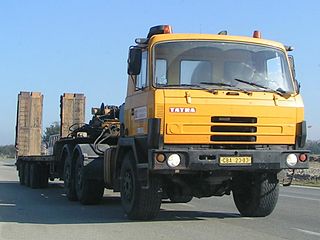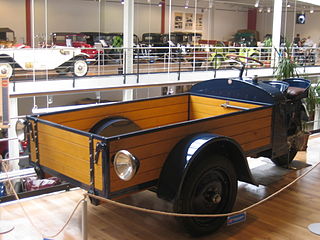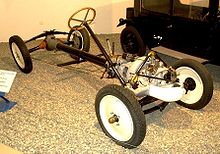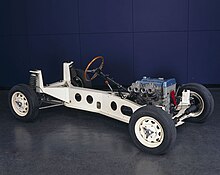
A Locost is a home-built car inspired by the Lotus Seven. The car features a space frame chassis usually welded together from mild steel 1 in × 1 in square tubing. Front suspension is usually double wishbone with coil spring struts. The rear is traditionally live axle, but has many variants including independent rear suspension or De Dion tube. Body panels are usually fiberglass nose and wings and aluminium side panels. Each car is highly individualized according to the resources, needs and desires of each respective builder.

Tatra is a Czech vehicle manufacturer from Kopřivnice. It is owned by the TATRA TRUCKS a.s. company, and it is the third oldest company in the world producing cars with an unbroken history. The company was founded in 1850 as Ignatz Schustala & Cie, in 1890 renamed in German Nesselsdorfer Wagenbau-Fabriksgesellschaft when it became a wagon and carriage manufacturer. In 1897, Tatra produced the first motor car in Central Europe, the Präsident automobile. In 1918, it changed its name to Kopřivnická vozovka a.s., and in 1919 it changed from the Nesselsdorfer marque to the Tatra badge, named after the nearby Tatra Mountains on the Czechoslovak-Polish border.

A torsion bar suspension, also known as a torsion spring suspension, is any vehicle suspension that uses a torsion bar as its main weight-bearing spring. One end of a long metal bar is attached firmly to the vehicle chassis; the opposite end terminates in a lever, the torsion key, mounted perpendicular to the bar, that is attached to a suspension arm, a spindle, or the axle. Vertical motion of the wheel causes the bar to twist around its axis and is resisted by the bar's torsion resistance. The effective spring rate of the bar is determined by its length, cross section, shape, material, and manufacturing process.

In architecture and structural engineering, a space frame or space structure is a rigid, lightweight, truss-like structure constructed from interlocking struts in a geometric pattern. Space frames can be used to span large areas with few interior supports. Like the truss, a space frame is strong because of the inherent rigidity of the triangle; flexing loads are transmitted as tension and compression loads along the length of each strut.

Hans Ledwinka was an Austrian automobile designer.

The Tatra 815 is a truck family, produced by Czech company Tatra. It uses the traditional tatra concept of rigid backbone tube and swinging half-axles giving independent suspension. The vehicles are available in 4x4, 6x6, 8x8, 10x8, 10x10, 12x8 and 12x12 variants. There are both air-cooled and liquid-cooled engines available with power ranging from 230–440 kilowatts (310–590 hp). As a successor to Tatra 813 it was originally designed for extreme off-road conditions, while nowadays there are also variants designated for mixed use. The gross weight is up to 35,500 kg (78,264 lb).

The TatraT813 was a truck produced in Czechoslovakia by the Tatra company. It was produced from 1967 to 1982. The basic representative of this series was a military version of the 8×8 Kolos (Colossus), which was able to pull trailers up to a total weight of 100 tons. Tatra also produced a civilian version in either 6×6 or 4×4. After fifteen years of production, 11,751 vehicles were built in all modifications. Many units were exported to the USSR, East Germany, Romania and India.

The Tatra 148 was a truck produced in Czechoslovakia by the Tatra company.

A vehicle frame, also historically known as its chassis, is the main supporting structure of a motor vehicle to which all other components are attached, comparable to the skeleton of an organism.

The Tatra T11 is an automobile that was produced from 1923 through 1927. It was the first Tatra model to use backbone tube chassis, swinging half-axles and air-cooled engine, the development of which is still in use on the trucks produced by Tatra to this day.

The Tatra 111 was a truck produced in Czechoslovakia by the Tatra company.

The Tatra 12 is a model of vintage automobile made by Czech manufacturer Tatra. It was manufactured between 1926 and 1933. It was replaced by the Tatra 57 in 1932.

The Tatra 26 is a vintage 6x4 automobile produced by the Czech manufacturer Tatra in the late 1920s and early 1930s. It was developed on the basis of the T 12. However, tests showed that the engine from T 12 did not have enough power, and it was replaced by the Tatra 30 engine. The car had extreme off-road abilities - reportedly it was even able to climb staircases.

The Tatra 49 is a model of vintage three-wheeled motor vehicle made by Czech manufacturer Tatra.

The Škoda Rapid is a mid-size car that was made in Czechoslovakia by Škoda from 1935 to 1947. Škoda had first applied the "Rapid" name to a version of its 1,195 cc Popular Type 920 made in 1934–35. From 1935, however, it transferred the name to a new, larger model.

The Škoda Popular is a small family car that was made in Czechoslovakia by Škoda from 1933 to 1946. It was the company's most affordable car at the time.

The original Škoda Superb is a full size luxury car that was made by the Czechoslovak car manufacturer ASAP, later AZNP from 1934 to 1949. It was the company's first car with a V8 engine and all-wheel drive.

The Tatra 815-7 is a heavy army logistics vehicle made by the Czech company Tatra produced since 2008. T817 is primarily intended for military operators and for specialist roles in civilian sector. The truck is made primarily with axle variations of 4×4, 6×6, 8×8 and 10×10. Other chassis variants up to 16x16 are also available.
The Škoda 637 is a Czechoslovak mid-size car that was made by Škoda from 1932 to 1935.

A platform chassis is a form of vehicle frame / automobile chassis, constructed as a flat plate or platform, sometimes integrating a backbone or frame-structure with a vehicle's floor-pan.























